The 6th Keith Richardson Memorial Tournament took place on Saturday, September 24th at Camberley Baptist Church and was organised by Camberley Chess Club.
Tag Archives: Tournament
Tata Steel Chess Tournament 2021
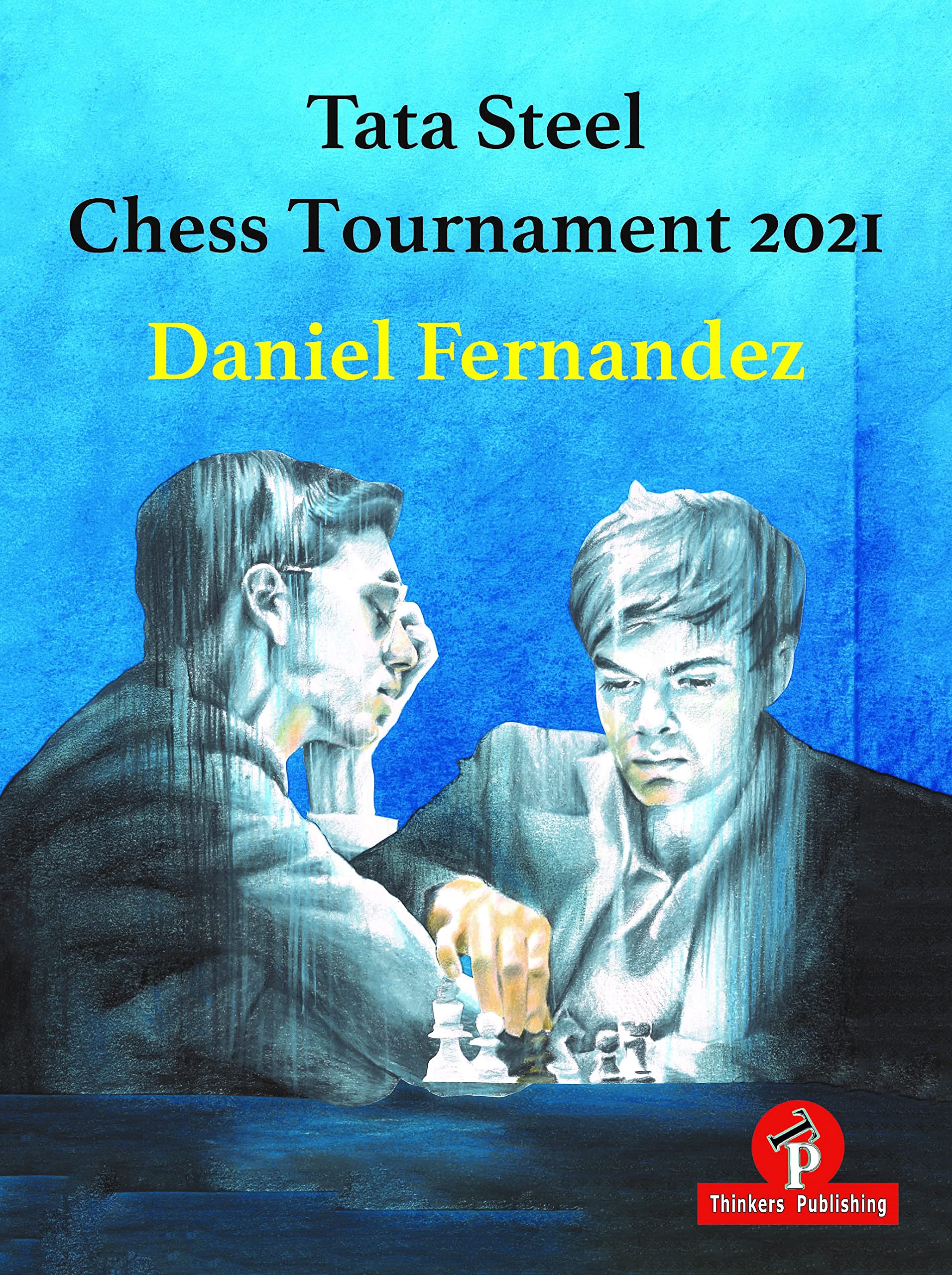
From the publishers’ blurb:
“That such a fine achievement should be immortalized, is beyond dispute. But who will pick up the gauntlet? We live in a volatile world where the Internet is dominant and when a tournament is over, the next one is already at the door. No time for reflection and historical awareness? Yet there was someone who had followed the tournament with great interest. The English grandmaster Daniel Fernandez, who also publishes for ChessPublishing came up with the idea of thoroughly examining all the games from this tournament. He did not take any chances in doing so. In addition to the various sources he found on the Internet, he of course used the strongest engines available at the moment. He also had engines in the cloud patiently calculate various positions. Together with his source research and his own insights, he has created a unique compilation of chess-technical material that is unprecedented.
In doing so, Fernandez has painted a fantastic picture of the opening variants that were on the board in this tournament. He has done a thorough research of the ins and outs of the various variants and placed them in a broader perspective. And it must be said that the organization was kind to him by providing an interesting field of players who gave it their all every round. This resulted in many nice confrontations with extremely interesting opening theory! That Fernandez did not get away with the middle game and the many fascinating endgames was clear from a first estimate of the amount of material when it had to be converted to the format of this book. Initially, we ended up with almost 900 pages! That is far too much and therefore drastic cuts had to be made. Hundreds of (analysis) diagrams have been dropped, small side notes are no longer in the book and sometimes – pain in the heart – the trees of variations had to be cut back. That only happened, by the way, when the ingenious structure became so extensive that it would be hard to follow for “mere mortals”. It is being considered whether this can be made available digitally at a later date, and the moment that it is, we will of course put Fernandez’s entire analytical work on offer! IM Herman Grooten, December 2021 ”
GM Daniel Fernandez (born 1995) is an English grandmaster with a slightly unusual approach to chess: at once mischievous and hardworking, and equally comfortable in tactical positions or dry endgames. His style fits the Modern perfectly and he has played it with success for almost a decade. He is a past holder of the British under-18 and under-21 titles, and the winner (or joint winner) of many open tournaments, such as Paracin 2017, Pula 2018, Ghent 2019 and the New Zealand Open 2020. Daniel also writes and commentates frequently, and is a columnist of the 1.e4 section on ChessPublishing.com. This is his third book for Thinkers Publishing, the Modernized Caro-Kann and Modern Defense were his first two and world wide acclaimed as the best you can get.
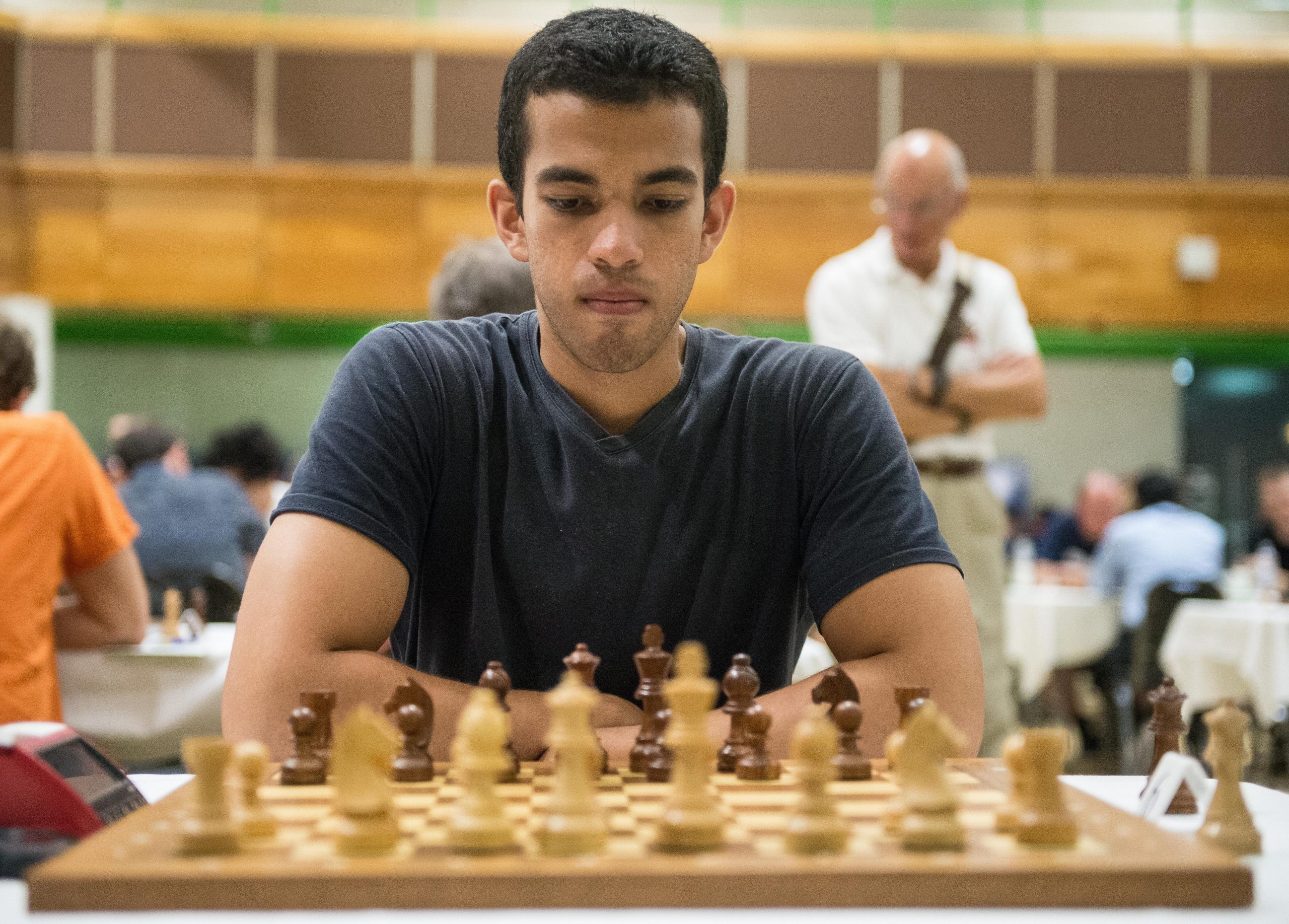
Chess book collectors will look back with fondness on the days when competitions between leading players were often commemorated by tournament books. Hastings 1895. New York 1924. The 1953 Candidates’ Tournament. Everyone with a passion for chess literature will have books such as these on their shelves. From time to time they’ll open them again, not just to admire the games but to relive the excitement of the event. Like me, they’ll regret that this tradition seems to have gone out of fashion.
Is this book a worthy addition to an almost forgotten genre of chess literature?
With 750 pages, trimmed down from an original almost 900, one can only admire Daniel Fernandez’s industry in compiling the book, in producing several pages of detailed analysis, often focused on modern opening theory, for almost every one of the 91, invariably hard-fought games produced by some of today’s leading Grandmasters.
The author has made an unexpected and seemingly unexplained decision in ordering the games by the player of the white pieces. So we start with all the White games of Alexander Donchenko, who eventually brought up the rear, through to those of Jorden van Foreest, the rather unexpected tournament winner.
I guess this makes sense if the main reason you’re reading the book is to study you heroes’ opening repertoires, but from my perspective as a humble club player it seems rather eccentric. Why not group the games by the player of the black pieces instead? Or, better still, why not group them by opening so that we can see all the Sicilian Defence, for example, games together? If, like me, you’re not especially interested in opening theory, you’d probably prefer a more conventional format, especially given that the book also includes the round summaries taken from a Dutch chess news website. So we get a Round 1 report, Donchenko’s white games, a Round 2 report, MVL’s white games and so on, which creates, at least for me, a rather disjoined effect.
The opening analysis is, for many games, extremely detailed. Take, for example, Esipenko’s win over Carlsen in round 8. We get five pages of notes about the latest trends in the Sicilian Najdorf, which I’m sure is deeply fascinating to anyone playing that opening with either colour at master level, but of only passing interest to someone like me who finds the opening far too difficult for comfort.
Esipenko sacrificed a pawn in the opening, reaching this position where he gained a winning advantage: 18. Ncxb5+ axb5 19. Nxc6 Qxc6 20. Qc3: a familiar enough sacrifice but with an unusual follow-up. The queen fork regains the piece and the World Champion eventually succumbed.
50 or more years ago, when I was young and innocent enough to look at opening theory, the Sicilian Najdorf was all the rage. It’s still popular now, although most of it looks very different from the days when we eagerly awaited the news of Bobby’s latest games. One line that’s still popular, and hasn’t changed all that much, is the Poisoned Pawn variation. To the best of my knowledge it’s still, in general, standing up well for Black, but it’s very easy to go wrong and lose quickly, as MVL found out against Caruana.
Black plumped for the wrong pawn capture on d5, and now White continued 14. e6!! A crushing breakthrough. After 14 moves Black is essentially lost against good play!, according to Fernandez, who provides some beautiful variations against various Black tries here.
As you’d expect, the tournament produced its fair share of fascinating endings. I found this position, from Wojtaszek – Anton Guijarro, particularly instructive.
Here Black played 58… Rg1!. Fernandez comments: Black shows alertness and does not allow the half-point to slip away. There are only a few dangers for Black in this position, and foremost among them would be allowing the enemy king into f6. Hence 58… Ra2?? loses, because Black now has to go very passive to prevent the infiltration.
He then goes on to give a lot of analysis demonstrating how White can always, at worst, reach the Lucena position.
The analysis of the remaining moves (59. Rb7 f6 60. e6 and so on) is also informative as to how this very typical position should be played.
At one level this is a magnificent, monumental book. You get 91 top level games, all deeply annotated, all hard fought, with profound opening play, often exciting middlegames and sometimes intricate endings. Fernandez has put in an enormous amount of work to ensure that readers are informed about the latest opening theory in lines currently popular at top GM level (although I guess it’s all 18 months out of date now!), and that all the analysis has been thoroughly checked for accuracy using the most powerful engines. The production values are high, with many excellent photographs and lots of interesting background material. I spotted a few typos, but not enough to spoil the book.
And yet, writing as a fairly strong club player, it’s sadly not a book for me. It’s just much too heavy, in more ways than one. Picking it up made my arms hurt and reading it made my brain hurt.
Give me a 250-300 page tournament book rather than 750 pages, and I’d be happy. I’d want the games in round order, annotated in a user-friendly (but not patronising) way, with opening theory and computer-generated variations only included where necessary, with helpful tips on how I could learn and improve my game and perhaps some reader interaction such as quiz questions. Indexes of openings and endings would also be welcome.
If you’re an ambitious 2200+ player, this book will, I’m sure, be ideal for you. If, like me, you’re an unambitious under 2000 player, you may well think it’s too much of a good thing.
I sometimes get the impression that there are a number of grandmasters who write books for themselves and their friends rather than considering the nature of their target market. For me this book, praiseworthy and outstanding though it undoubtedly is, falls into that category.
I’d advise you to make up your own mind whether this is a book for you. If you click here you’ll be able to download a teaser.
Richard James, Twickenham 28th June 2022

Book Details :
- Softcover: 750 pages
- Publisher: Thinkers Publishing; 1st edition (14 Feb. 2022)
- Language: English
- ISBN-10: 9464201428
- ISBN-13:978-9464201420
- Product Dimensions: 17.02 x 4.57 x 23.62 cm
Official web site of Thinkers Publishing

Candidates Tournament 2020 : Part 1 Yekaterinburg
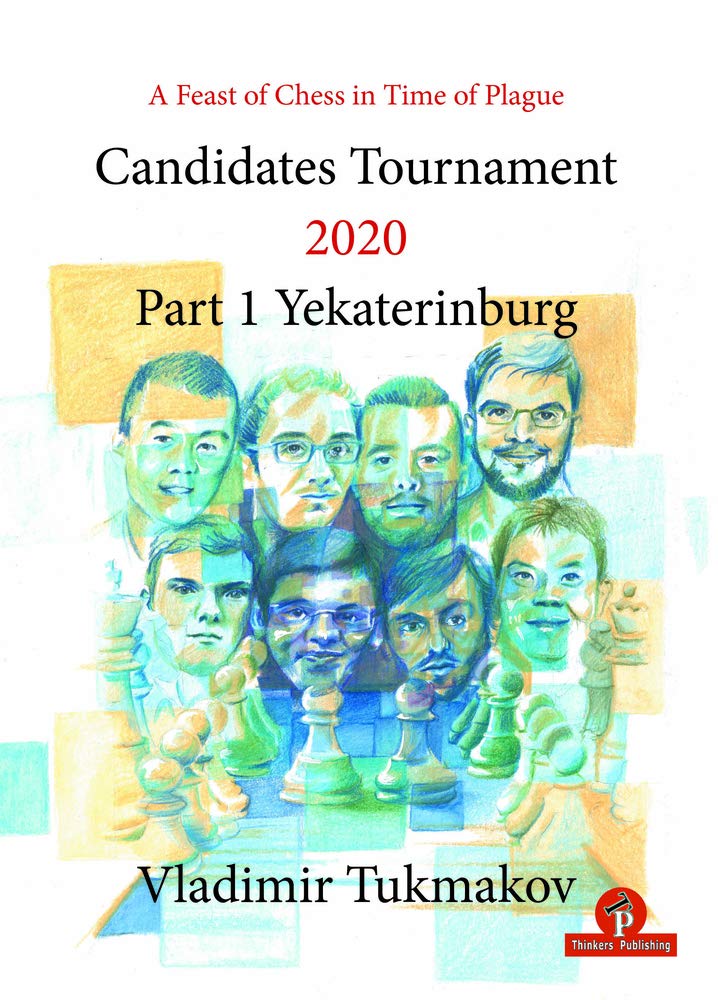
From the rear cover :
“Vladimir Tukmakov, born in Odessa 1946, was one of the strongest Ukrainian grandmasters. He was the winner of several strong tournaments, including the Ukrainian Championship in 1970, and he came second in three Soviet championships in 1970,72 and 83. After his successful period as active player, he became a coach, trainer and author. This is his second book for Thinkers Publishing, after his major success in 2019 with ‘Coaching the Chess Stars’.”
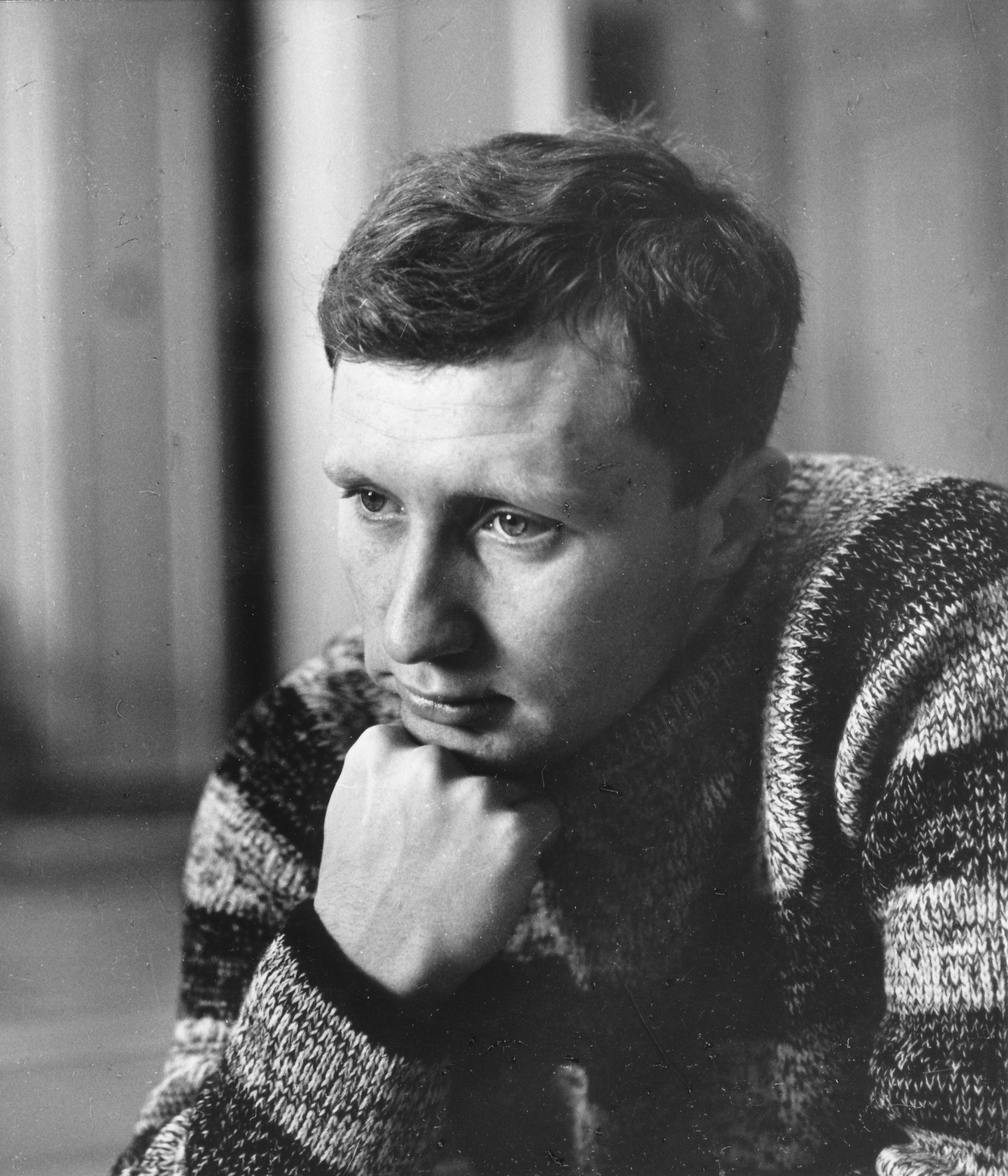
Also from the rear cover
“The official story of the 2020 Candidates Tournament began on November the 11th, 2019 with the signing of a contract between FIDE and the Russian Chess Federation detailing the hosting duties of said tournament in Ekaterinburg from the 15th of March to the 5th of April, 2020. At that point no one could have even imagined how difficult the road to that tournament would be nor how unexpected the outcome. Yet the significance of the actual numbers in this dramatic epic is hard to overestimate which is why the author will attempt to play the role of chronicler and try to describe as accurately as possible the key moments of this historic event. Vladimir Tukmakov was our close observer, author and wrote a historically important book on the first part of the Candidates 2020.”
Tournament books, once a staple of chess literature, have been rare in recent years and books about half a tournament have always, naturally, been rarer still. This book by GM Vladimir Tukmakov is just such a book – and in my opinion it is a very welcome one.
Of course, 2020 has been an exceptional year (in a bad sense of exceptional) and the Candidates Tournament stands out as the exceptional (in a good sense of exceptional) over-the-board elite event of the year. It is unfortunate that Covid-related reasons forced the tournament to be suspended before its conclusion. (Or was the suspension necessary? The author’s comments on the decision are interesting.)
Although the tournament started on schedule in March, it was already in somewhat controversial circumstances because Teimour Radjabov had withdrawn – citing the rapid spread of the pandemic – and had been replaced by Maxime Vachier-Lagrave. The tournament was suspended exactly half way through following an announcement by the Russian government that all international air travel had been suspended indefinitely. The eight Candidates had been due to play each other twice, and seven of the fourteen rounds had been completed.
The author of this book, now aged 74, has been pretty much inactive as a player in recent years but he was a top player for a number of years, coming second in the Soviet Championship on three occasions, and reaching number 12 in the world rankings. This quality is reflected in his game annotations even if they are – as he modestly admits – sometimes helped by his “Iron Friend” (as he refers to chess engines).
The book consists of the following sections:
Introduction: Three pages of he author’s reflections on why he chose to write this book.
Prelude: Nine pages which describe the tournament itself, its participants and its occurrence in the time when the pandemic was developing.
The Play: 121 pages of games, with each of the 28 games annotated by the author and with a summary of the situation after each round.
Unexpected Conclusion: A brief two page description of the suspension.
Interim Results: An eight page summary of the tournament (so far!) including general observations of the players and their prospects for the remainder of the tournament, whenever that will be.
The Prelude and Interim Results chapters are informative and are engagingly written. They include a number of personal reflections by the author. The annotations in The Play chapter are, I think, superb, with both textual comments and given variations always hitting the spot in their relevance. An example of this is taken from his notes to the Ding-Caruana game:
12 d5!?
Another complicated decision. The position demanded 12.e3 in the hope of completing development after 12… Bb3 which was like the game. Also, worth considering was 12… Bg6!? 13.Bc4 (Although 13.Nd3 led to an even more complicated struggle. For instance, 13…Na6 14.Nxb4 Nxb4 15.dxc5 Nc2 16.Rb1 Qa5) 13… Bxc4 14.Nxc4 cxd4 15.exd4 (15.Qxd4 Qe7) 15… Nc6 with enough compensation for the pawn.
It is very revealing, that having found himself in a difficult psychological situation, the Chinese grandmaster does not rush towards simplification instead choosing a more difficult and principled continuation each time.
(The book actually uses figurines for the pieces.)
Tukmakov is generally very respectful of the great players who are taking part in the tournament (indeed he writes that the book “bears witness to my solidarity with my younger colleagues” in view of their bravery in playing under the circumstances of the pandemic), but this doesn’t stop him from criticising them. For example, their clock handling occasionally comes in for comment. On one occasion he writes:
It is difficult to understand what Giri thought about for 25 minutes.
As may perhaps be expected, Grischuk receives sterner criticism in this area – but criticism that is well reasoned (and somewhat humorous).
In summary, I really like this book. I look forward to the second instalment which I hope arises as and when the second half of the tournament is complete. Who knows, perhaps tournament books are not a thing of the past after all?
Colin Purdon, Crowthorne, Berkshire, November 11th 2020

Book Details :
- Flexicover : 160 pages
- Publisher: Thinkers Publishing; 1 edition (8 Dec 2020)
- Language: English
- ISBN-10: 9492510928
- ISBN-13: 978-9492510921
Official web site of Thinkers Publishing
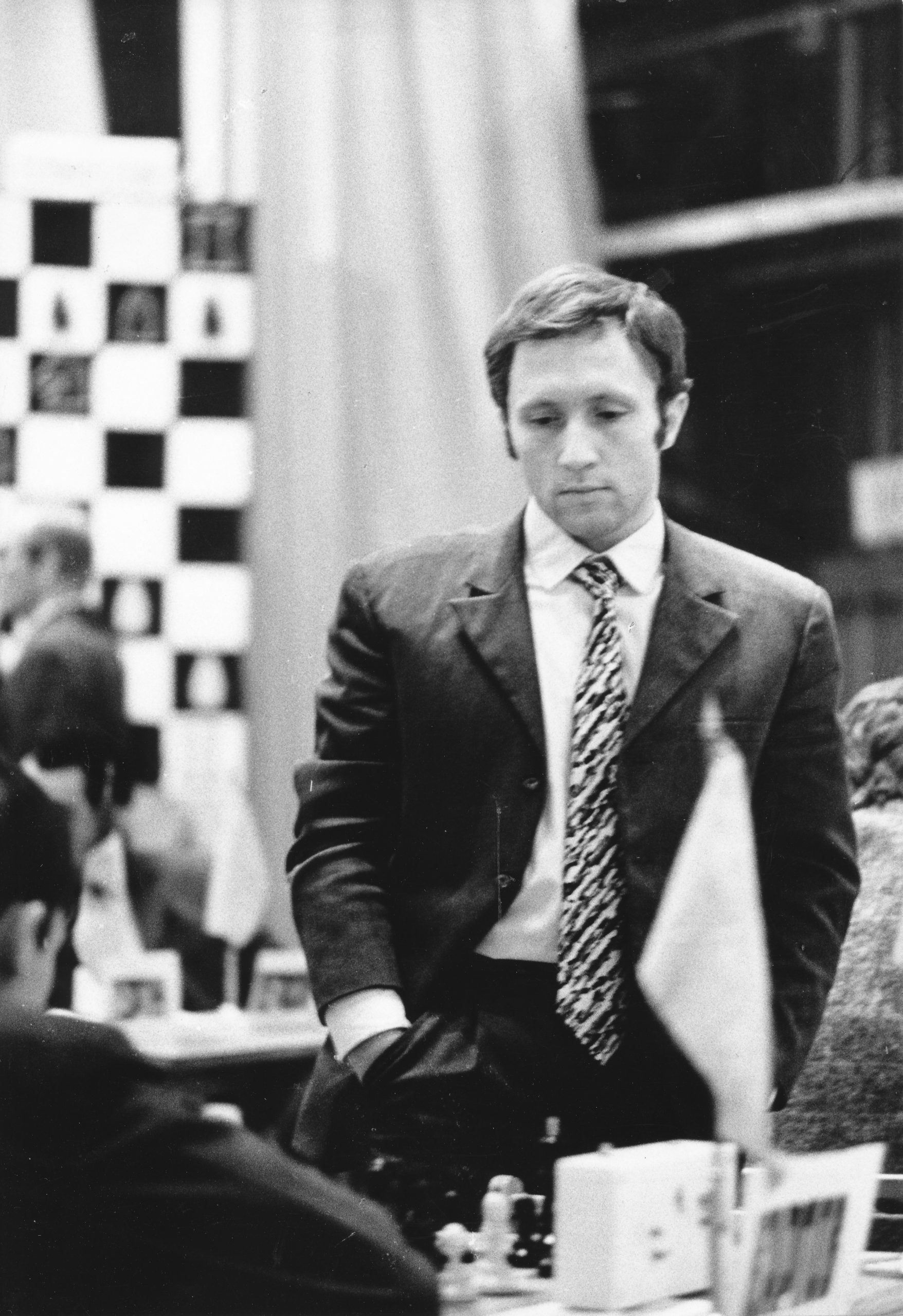

The Gijon International Chess Tournaments, 1944-1965

The Gijon International Chess Tournaments, 1944-1965 : Pedro Méndez Castedo & Luis Méndez Castedo
Pedro Méndez Castedo & Luis Méndez Castedo
Pedro Mendez Castedo is an amateur chess player, an elementary educational guidance counselor a member of the Asturias Chess History Commission, a bibliophile and a researcher of the history of Spanish and Asturian chess. He lives in San Martin del Rey Aurelio, Spain. Luis Mendez Castedo is an amateur chess player, a full teacher at a state school, a member of the Asturias Chess History Commission, a bibliophile and an investigator of the history of Spanish chess. He lives in Gijon, Spain.
When I mention Gijón, what’s the first thing that comes to mind? Mustard? No, that’s Dijon. Dijon’s in France, but Gijón’s on the north coast of Spain, on the Bay of Biscay.
Small international chess tournaments were held there between 1944 and 1951, then between 1954 and 1956, and, finally, in 1965. These were all play all events, with between 8 and 12 players: a mixture of visiting masters and local stars. A bit like Hastings, you might think, but these tournaments usually took place in July, not in the middle of winter.
The strength of the tournaments varied, but some famous names took part. Alekhine played in the first two events and Euwe in 1951. A young Larsen played in 1956, while other prominent masters such as Rossolimo, Darga, Donner, Prins, Pomar and O’Kelly also took part. The local player Antonio Rico played in every event, with fluctuating fortunes: winning in 1945 ahead of Alekhine and 1948, but also finishing last on several occasions. English interests were represented on three occasions by Mr CHESS, BH Wood.
A nice touch is the Foreword, written by Gene Salomon, a Gijón native who played in the 1947 event before emigrating first to Cuba and then to the United States.
The main part of the book comprises a chapter on each tournament. We get a crosstable and round by round individual scores (it would have been better if these didn’t spill over the page: you might also think that progressive scores would be more useful). We then have, another nice touch, a summary of what was happening in the world at large, and in the chess world, that year. Then we have a games selection, some with light annotations: words rather than variations, giving the impression that little if any use was made of engines.
The book concludes with a chapter on ‘Special Personages’: Félix Heras, the tournament organizer, and, perhaps to entice British readers, BH Wood. Appendices provide a table of tournament participation and biographical summaries of the players.
Returning to the main body of the book, let’s take the 1950 tournament as a not entirely random example. A year in which I have a particular interest.
We learn a little about the football World Cup, the Korean War and a Spanish radio programme, the first Candidates Tournament and the Dubrovnik chess olympiad.
The big news from Gijón was the participation of the French player Chantal Chaudé de Silans, the only female to take part in these events, and rather unfairly deprived of her acute accent here. She scored a respectable 3½ points, beating Prins and Grob (yes, the 1. g4 chap).
Rossolimo won the event with 8½/11, just ahead of Dunkelblum and Pomar on 8. Prins and Torán, playing in his home city, finished on 7 points.
This game, between Arturo Pomar and Henri Grob, won the first brilliancy prize.
1. d4 Nf6 2. c4 g6 3. Nc3 d5 4. cxd5 Nxd5 5. g3 Bg7 6. Bg2 c6 7. e3 h5 8. Nge2 h4 9. Qb3 Nxc3 10. bxc3 Nd7 11. a4 Nb6 12. a5
12… Nd7 13. a6 Qc7 14. Qc4 Nb6 15. Qc5 Rh5 16. Qa3 bxa6 17. Nf4 Rh8 18. Qc5 Bb7 19. Ba3 e5 20. Nd3 exd4 21. cxd4 Rh5 22. Ne5 O-O-O 23. g4 Nd7 24. Qc2 Rxe5 25. dxe5 Nxe5 26. Rb1 h3 27. Be4 Nxg4 28. Ke2 a5 29. Rxb7 Kxb7 30. Rb1+ Kc8 31. Bxc6 Ne5 32. Bb7+ Kb8 33. Ba6+ Qb6 34. Bd6+ Ka8 35. Rxb6 1:0
The annotations – by result rather than analysis – neither convince nor stand up to computer scrutiny. We’re told at the start of the game that ‘Pomar takes the initiative from Black’s error in the opening and does not relinquish it until the final victory’, but the annotations refute this claim. After criticizing several of Grob’s moves but none of Pomar’s, we’re told, correctly, that Black could have gained an advantage by playing 25… Qa5+. However, Grob’s choice was second best, not a ‘serious mistake’: Stockfish 10 tells me 26… a5 was still better for Black, and 27… a5 (in both cases with the idea of Ba6) was equal, though I guess those moves might not be easy to find without assistance. It was his 27th move, and perhaps also his 26th, which deserved the question mark.
This game was played in the last round of the tournament, on 26 July 1950. Two days later a boy would be born who would learn chess, develop an interest in the game’s history and literature, and be asked to review this book. What is his verdict?
An enjoyable read, a nice book, but not a great book. If you collect McFarland books you’ll want it. If you have a particular passion for Spanish chess history, you’ll want it. Otherwise, although the book is not without interest, it’s probably an optional extra.
The tournaments, apart perhaps from Alekhine’s participation in the first two events, are not, in the overall scheme of things, especially significant. The games, by and large, aren’t that exciting. The annotations are, by today’s standards, not really adequate. The translation and presentation could have been improved.
Just another thought: we could do with a similarly structured book about the Hastings tournaments. There was one published some years ago, but a genuine chess historian could do much better.
Richard James, Twickenham 20 November 2019

Book Details :
- Softcover : 244 pages
- Publisher: McFarland (30 July 2019)
- Language: English
- ISBN-10: 1476676593
- ISBN-13: 978-1476676593
- Product Dimensions: 17.8 x 1.5 x 25.1 cm
Official web site of McFarland

Third Keith Richardson Memorial : September 14th 2019

A glorious Saturday (the 14th) in September was the date and Camberley Baptist Church was the location of the third tournament in memory of correspondence Grandmaster Keith Bevan Richardson.

A field of thirty-two gathered at the home (since 1982) of Camberley Chess Club for a six round rapid-play event (R20′ + 10″) that was free to enter raising money by donations to The Cure Parkinson’s Trust. Players were invited to choose books from Keith’s library

and donate to charity in return.

Top seed was recently qualified IM Adam C Taylor (ECF230)
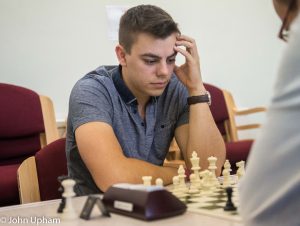
whose chances were dented by losing in round 4 to Clive Frostick (Farnham) who, like Keith, was a highly successful correspondence player (a SIM : Senior International Master)
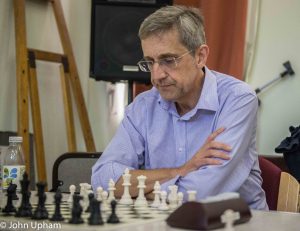
Other pre-tournament favourites were FM Andrew P Smith (IRE and Bourne End)

and FM Richard M Webb (Crowthorne)
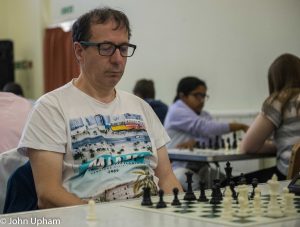
along with WFM Louise Head (Crowthorne)
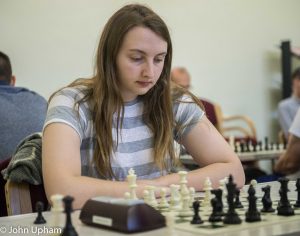
Following three rounds we stopped for lunch (in some cases liquid only) and on 100% were Adam, Clive and Andrew so round four could well be a key decider. Clive beat Adam with the white pieces whereas Andrew and Richard drew a hard fought Sicilian Dragon. In round five Clive breathed a sigh of relief to survive a “dodgy” position against Colin Purdon in one of the candidate games for the “Best Swindle” Prize.
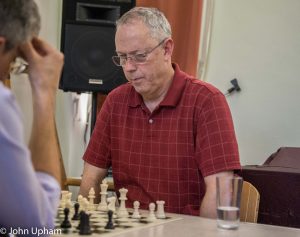
The drama continued into the final round as Adam beat strong junior Ranesh Ratnesan
and everything hinged on Clive’s game with Richard Webb. After a long and interesting struggle the game was drawn and the tournament was decided.
The award for Best U-150 player went to rapidly improving Jessica Mellor (Guildford)
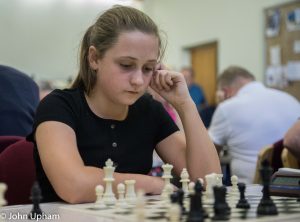
the award for Best Junior went to Radesh Ratnesan (Surbiton)
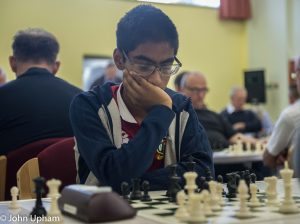
and the title of Camberley Chess Club Champion (highest placed local player) went to Colin Purdon

In overall first place with 5.5/6 was Clive Frostick :

The event collected more than £300 for the Cure Parkinson’s Trust and we are sure Keith was looking down from above and was pleased with what he observed.
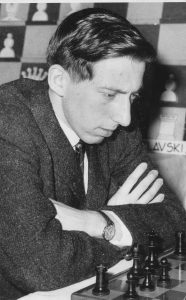
Past Winners of Keith Richardson Memorial :
2017 : Julien Shepley
2018 : Ken Norman
2019 : Clive Frostick
Full results may be found from UTU Swiss
Camberley Chess Club would like to thank :
Camberley Baptist Church, Berkshire Junior Chess Association, Ken Coates and Christine Coates.
The organiser was John Upham.
British Blitz Championship Qualifier : Bristol
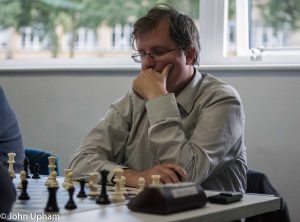
Sixty-four (!) players entered the South-West qualifier for the British Blitz Championship 2019 held at Bristol Grammar School for a fifteen round tournament employing a 3′ + 2″ FIDE approved time control.

The entry was headed by GM Matthew Turner (SCO) scoring 13.5/15 and gaining a mere 8.8 FIDE Blitz rating points drawing quickly with Keith Arkell and losing to FM Lewis Martin (ENG).
Paignton based “local” GM Keith Arkell (ENG) took runner-up spot with 12/15 losing 15 rating points having drawn with Lewis Martin but losing to in-form IM James Cobb (WLS) and IM Malcolm Pein (ENG). Malcolm’s son Jonathan elected to play in the much weaker Belfast qualifier which was probably a good move.
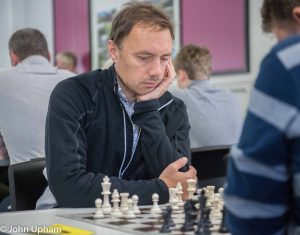
Highest placed lady player (and therefore qualifier) on 8.5/15 was University of Warwick student and reigning English Ladies Champion, WFM Louise Head (ENG) who was supported by her Crowthorne team mates FM Richard Webb, Colin Purdon and Mark Taylor.
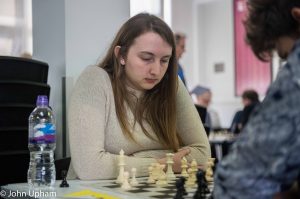
Surprise performance (perhaps?) was from FM Lewis Martin (title awarded in 2018) who beat Matthew Turner, Malcolm Pein, Richard Webb and Louise Head of the titled players to earn a 64.8 rating increase.
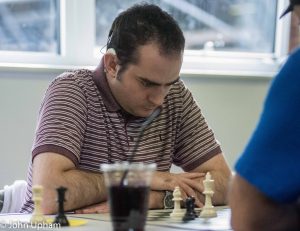
Full results may be found at Chess Results . com
Today in Torquay…
BCN has joined the action in wonderful Torquay at the Riviera Centre.
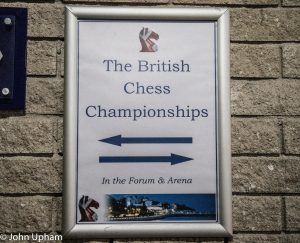
On Board four we have IM Richard Pert vs GM Nick Pert (Richard won the game) :

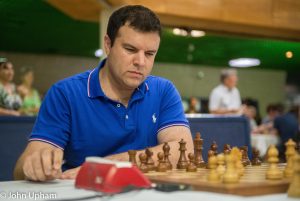
and on board three : GM John Emms vs GM Justin Tan (the game was drawn) :
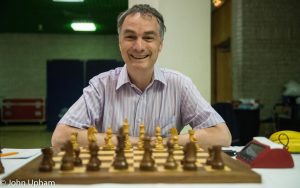

and on board two : IM Richard Palliser vs GM Stephen Gordon (the game was drawn) :
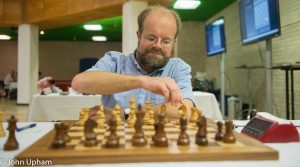
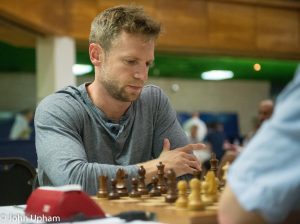
and on top board we have GM David Howell vs GM Michael Adams (the game was drawn) :
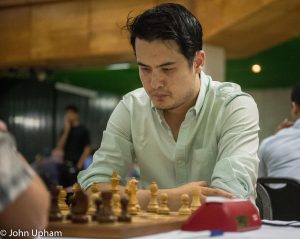

Follow the action at Twitch with GM Danny Gormally and IM Adam Hunt




























































































































